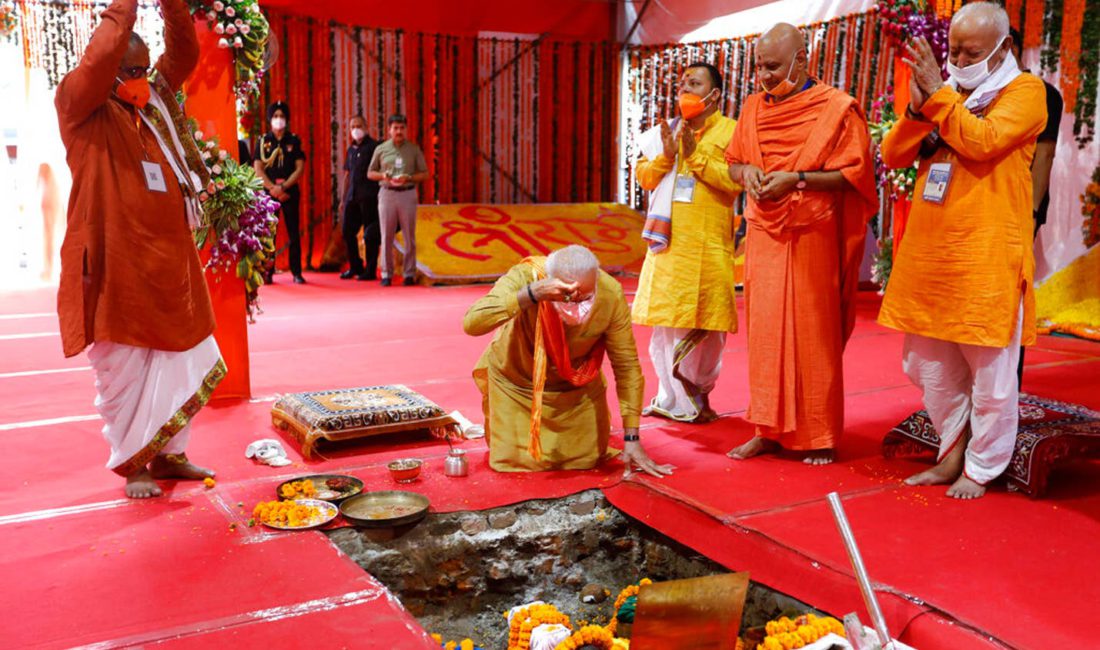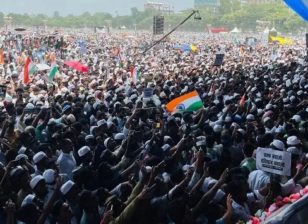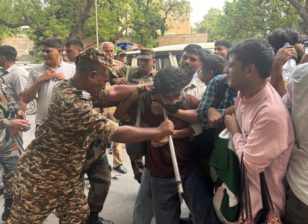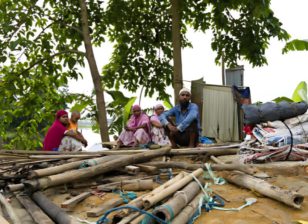Haaretz: Hindu Mobs, anti-Muslim Boycotts: In Modi’s India, the Echoes of 1930s Germany Are Growing Louder
Modi is talking to world leaders about the threat of Islamist radicalization. But the real threat to India comes from a radicalizing Hindu majority fueled by the increasingly brazen, violent anti-Muslim bigotry of Modi’s own party
Taking part in the nine-member Shanghai Cooperation Organization summit just over a week ago, India’s Prime Minister Narendra Modi voiced a familiar concern in the region following the Taliban takeover of Afghanistan: the heightened risk of Islamist fundamentalism.
In his speech, delivered virtually, he urged the members, which include China, Russia and central Asian countries, to join forces to fight “radicalization and extremism.”
Religious fundamentalism, he noted, had historically been a barrier to development in Central Asia, and urged member countries to promote “rational thinking” as a counter to radicalization.
The creation of a potentially new haven of jihadi terror in Asia is a legitimate cause of concern for countries in the region with disaffected Muslim youths and ongoing insurgencies, such as in Mindanao and Kashmir. The governments of Malaysia, Indonesia and the Philippines have for long been dreading the return of the thousands of young men who left those countries to join ISIS in Syria.
Modi could breathe easy on this front, though. Much to the surprise of international security analysts, Indian Muslims have historically stayed away from global jihad movements. Neither were Indian Muslims drawn to the mujahideen resistance in Afghanistan against the Soviet occupation in the 1980s nor to the subsequent al-Qaida-Taliban “emirate.” They proved equally impervious to the toxic appeal of ISIS.
The 100-odd Indians who joined ISIS — of the nearly 200 million Muslims in the country — accounted for less than 1 percent of the estimated 40,000 foreign fighters of the “caliphate.”
But, for Modi, whose Hindu nationalist Bharatiya Janata Party (BJP) uses Muslims as the electoral bogeyman to consolidate a culturally diverse and caste-riven Hindu vote base against a common “other,” it makes sense to bang on about Muslim “radicalization” all the same, as a means of Hindu mobilization.
In reality, the radicalization of the majority is a much bigger threat confronting India than minority extremism.
Lynching of Muslims by Hindu mobs have become so normalized that they rarely make news anymore. New laws against beef and interfaith love – termed “love jihad” by Modi’s party – now allow Hindu vigilante groups to attack Muslims with impunity. A pliant civil administration and police force mostly look away, if they’re not actively collaborating with the vigilantes.
Ever since Modi’s thumping re-election in 2019, he has doubled down on the Hindu majoritarian project of remaking India’s secular republic as a Hindu state, and arm’s-length vigilante groups allied with the ruling party’s Hindu-first world view play a significant role in asserting the new order.
Atrocious hate crimes and speeches by these fundamentalist groups offer a daily reminder to the Muslims of the new social hierarchy in a changing India, where Muslims can at best hope to be second-class citizens.
It’s the new normal in the “New India,” a term that Modi’s supporters use as shorthand for a golden era under an efficient and muscular Hindu leader who is ending corruption, bringing prosperity and showing Muslims their place in the Hindu-majority country.
When Modi bid for national power in 2014, he ran on a campaign of inclusive growth, with the slogan of “development for all.” But overseeing an economy that has progressively worsened under him, Modi has returned to his core competence of divisive politics to maintain support in the face of the death and destruction as a result of his poor handling of COVID.
The core messaging that emanates these days from Hindu supremacists is that development is not possible for all because Muslims, who constitute 14 percent of the population, are eating up the fruits of progress that should accrue to the Hindus, who account for 80 percent. Quite literally. Recently, the chief minister of India’s biggest state, Uttar Pradesh, which has a population the size of Brazil, triggered a controversy when he blamed Muslims for cornering the government-subsidized food meant for all.
For Modi’s party, openly Islamophobic campaigns such as these help to avoid scrutiny and debate over governance and turn elections into a referendum for protecting the supposedly endangered majority. With the politically important Uttar Pradesh heading for elections in less than six months, the same strategy is at play again, only this time with an added twist and urgency.
Uttar Pradesh is a must-win state for Modi. It contributes the most seats to the Parliament and is the epicentre of the Hindu nationalist movement over a mosque that Hindu fanatics demolished in 1992, turning the BJP into a national political force from a fringe party. The BJP won the last election in the state in 2017 on the promise of building a Hindu temple at the site of the razed mosque. Modi inaugurated the temple in 2020, calling it a “symbol of [India’s] nationalism.”
Anything short of a convincing victory in Uttar Pradesh will jeopardize Modi’s dream march. Be it the COVID catastrophe, the farmers’ protests or the crashing economy, Modi has so far weathered it all.
But the slightest sign of cracks in Uttar Pradesh will undo the carefully crafted image of invincibility, built in large measure by a combination of docile media coverage, ruthless use of force, surveillance and intimidation against dissenters and a steady drip of ever more audacious levels of bigotry that act to both distract and divide voters.
With not much to show for its last five years in the state, the memories of COVID losses and hardships still raw, and an intensifying farmers’ protest that threatens splits in its captive Hindu voter base, the BJP is left with no choice but to escalate its campaign of hate. Accordingly, radical supremacists calling for genocide are becoming increasingly common. Videos of small groups of self-appointed saviors of Hinduism tormenting lone Muslims are showing up on social media more often than before.
Many of these attacks are now aimed at driving Muslims out of their livelihoods and businesses. While Modi waxes eloquent on global forums on the need for “rational thinking” to counter radicalization, Hindu fanatics linked to his party have been warning salons and shops against hiring Muslim men.
A group of Hindu men set upon a Muslim bangle seller in the northern city of Indore last month. They did not take kindly to him interacting with Hindu women.
The bangle seller was guilty of just the kind of “dangerous” encounter a prominent supremacist leader connected to the BJP (whose self-declared mission is to “remove Muslims from the face of Earth”) has been warning of – Muslim vendors, plumbers and electricians visiting Hindu homes and gaining proximity to the women of the household while the men are away at work.
Muslim hawkers have faced random attacks and been driven out of Hindu villages. In the capital Delhi itself, there have been concerted campaigns to boycott Muslim vendors and businesses.
In the northeastern state of Assam, where Modi’s party has dehumanized Muslims by calling them “termites” who eat away the country’s resources, the government is now evicting them from their homes to give the land away for farming to “indigenous” people. The ruthless eviction drive last week led to shocking killings of poor Muslims.
Muslims, the most economically disadvantaged group and grossly underrepresented in the formal economy, are often found engaged in low-end casual work or self-employment in the informal economy. These growing attacks thus threaten to hit one of the most vulnerable sections of the Indian population.
Big businesses are feeling the heat, too. A Bangalore-based food start-up owned by a Muslim entrepreneur had to issue an official denial this month after a social media campaign to boycott its products for using cattle bones as ingredients and employing only Muslims, both outrageously unfounded allegations.
Persistent attacks on the meat and leather trades, through lynching and cattle seizures, have been common since Modi took power. They have had a crippling effect on small-time traders and intermediaries in the meat business, who happen to be mostly Muslims. Of late, big companies involved in the meat business are also being targeted by online campaigns branding halal certification as a form of “economic jihad” that ought to be resisted by Hindus.
The economic attacks on Muslims may still appear too dispersed and episodic to raise fears of a concerted state campaign to formally exclude Muslims. Modi’s India hasn’t yet reached the stage of the Judenboykott, the Nazi boycott of Jewish businesses that formally started in 1933 before slowly gathering pace, leading ultimately to the mass murder of Jews in the “final solution.”
But even the Judenboykott did not come about overnight. In the 1920s, boycotting Jewish businesses began to be normalized by Germany’s right-wing parties at the regional level, long before it became declared state policy.
Under a party born of a nearly 100-year-old Hindu nationalist movement inspired by 20th century European ethnonationalism, is India heading the same way?
We don’t know yet. But it’s a question worth posing to Modi as he steps out into the world this week after a gap of more than a year. Just in case it is, the world needs to know – if it doesn’t want to be caught unawares, again.
This article first appeared in Haaretz.com




